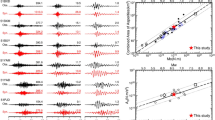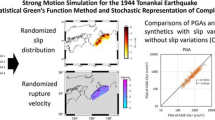Abstract
The empirical Green’s function (EGF) method is used to simulate the 2004 Parkfield earthquake (Mw = 6.1). The strong motion generation areas (SMGA) are estimated to reproduce near-source ground motions in a broadband frequency range of 0.25–10 Hz. In this simulation, the EGF uses the small events that occurred in 2005 (Mw = 4.5), 2012 (Mw = 4.4), 2010 (Mw = 4), and 2007 (Mw = 4). The source spectral ratio estimates the seismic moment ratio between large and small events whose corner frequencies obey the omega-squared scaling law. The estimated SMGA is 12 km in length by 8 km in width and is located near the large slip area of the waveform inversion. The result shows that the rupture propagates radially from the southeastern bottom part of the SMGA toward the northwestern shallow direction. In addition, a characterized source model comprising two asperities and a background slip area is proposed. The rupture propagates from asperity1 toward asperity2 with 2 s time delay. The characterized source model simulates more accurately than the single SMGA. The comparison between the 5% damped pseudo acceleration response spectra of our simulations verifies a better compatibility for more than 2 Hz.












Similar content being viewed by others
References
Aki, K. (1967). Scaling law of seismic spectrum. Journal of Geophysical Research,72, 271–1231.
Barnhart, W. D., & Lohman, R. B. (2010). Automated fault model discretization for inversions for coseismic slip distribution. Journal of Geophysical Research,2010, 115. https://doi.org/10.1029/2010JB007545.
Brune, J. N. (1970). Tectonic stress and the seismic shear waves from earthquakes. Journal of Geophysical Research,75, 4997–5002.
Brune, J. N. (1971). Correction. Journal of Geophysical Research,76, 5002.
CESMD (2016). https://www.strongmotioncenter.org. Accessed Mar 2016.
Custodio, S. (2007). Earthquake rupture and ground-motions: The 2004 Mw 6 Parkfield earth-quake. Ph.D. thesis, University of California, Santa Barbara.
Custodio, S., Liu, P., & Archuleta, R. (2005). The 2004 Mw 6.0 Parkfield, California, earthquake: Inversion of near-source ground motion using multiple data sets. Geophysical Research Letters,32, 23312.
Das, S., & Kostrov, B. V. (1986). Fracture of a single asperity on a finite fault: a model for weak earthquakes in earthquake source mechanics. American Geophysical Monograph,37, 91–96.
EQuake-RC (2016). http://equake-rc.info/srcmod. Accessed March 2016.
Hartzell, S. H. (1978). Earthquake aftershocks as Green's functions. Geophysical Research Letters, 5, 1–4.
Hartzell, S. H., & Heaton, T. H. (1983). Inversion of strong ground motion and teleseismic waveform data for the fault rupture history of the 1979 Imperial valley, California earthquake. Bulletin of the Seismological Society of America,73, 1553–1583.
Houlie, N., Dreger, D., & Kim, A. (2014). GPS source solution of the 2004 Parkfield earthquake. Nature-Scientific Reports,4, 3646.
Irikura, K. (1983). Semi-empirical estimation of strong ground motions during large earthquakes. Bulletin of the Disaster Prevention Research Institute Kyoto University,33, 63–104.
Irikura, K. (1986). Prediction of strong acceleration motions using empirical Green’s function, in Proc 7th Japan earthquake engineering Symp, 151–156, Tokyo.
Irikura, K., Kagawa, T., & Sekiguchi, H. (1997). Revision of the empirical Green’s function method by Irikura (1986). Seismological Society of Japan,2, B25.
Irikura, K., & Kamae, K. (1994). Estimation of strong ground motion in broad-frequency band based on a seismic source scaling model and an empirical Green’s function technique. Annali di Geofisica,37, 1721–1743.
Irikura, K., & Miyake, H. (2011). A recipe for predicting strong ground motion from crustal earthquake scenarios. Pure and Applied Geophysics,168, 85–104.
Ji, C. (2004). Slip history of the 2004 (Mw 5.9) Parkfield Earthquake (Single-Plane Model), Caltech, Parkfield 2004, California.
Johanson, I. A., Fielding, E. J., Rolandone, F., & Burgmann, R. (2006). Coseismic and Postseismic slip of the 2004 Parkfiled earthquake from space-geodetic data. Bulletin of the Seismological Society of America,96, S269–S282.
Kamae, K., & Irikura, K. (1998). Source model of the 1995 Hyogo-ken Nanbu earthquake and simulation of near-source ground motion. Bulletin of the Seismological Society of America,88, 400–412.
Kanamori, H. (1979). A semi-empirical aaproach to prediction of long period ground motions from great earthquakes. Bulletin of the Seismological Society of America, 69, 1645–1670.
Mena, B., Durukal, E., & Edrik, M. (2006). Effectiveness of hybrid Green’s function method in the simulation of near-field strong motion: An application to the 2004 Parkfield earthquake. Bulletin of the Seismological Society of America,96, S183–S205.
Mendoza, C., & Hartzell, S. (2008). Finite-Fault Analysis of the 2004 Parkfield, California Earthquake Using Pnl Waveforms. Bulletin of the Seismological Society of America,98(2746–2755), 2008.
Miyake, H., Iwata, T., & Irikura, K. (1999). Strong ground motion simulation and source modeling of the Kagoshima-Ken Hokuseibu earthquakes of March 26 and May 13, 1997, using empirical Green’s function method. Zisin,51, 431–442.
Miyake, H., Iwata, T., & Irikura, K. (2001). Estimation of rupture propagation direction and strong motion generation area from azimuth and distance dependence of source amplitude spectra. Geophysical Research Letters,28, 2727–2730.
Miyake, H., Iwata, T., & Irikura, K. (2003). Source characterization for broadband ground-motion simulation: Kinematic heterogeneous source model and strong motion generation area. Bulletin of the Seismological Society of America,93, 2531–2545.
Sadeghi, H., Miyake, H., & Riahi, A. (2013). Strong ground motion simulation of 2003 Bam, Iran, earthquake using the empirical Green’s function method. Journal of Seismology,17, 297–312.
Somerville, P., Irikura, K., et al. (1999). Characterizing crustal earthquake slip models for the prediction of strong ground motion. Seismological Research Letters,70, 59–80.
Zeng, Y., Aki, K., & Teng, T. (1993). Mapping of the high-frequency source radiation for the Loma Prieta earthquake, California. Journal of Geophysical Research: Solid Earth,98, 11981–11993.
Acknowledgements
We used strong motion records from the strong motion data center of CESMD. We should acknowledge source inversion validation (SIV) and the eQuake-RC websites which have provided a platform for simulation validation.
Author information
Authors and Affiliations
Corresponding author
Additional information
Publisher's Note
Springer Nature remains neutral with regard to jurisdictional claims in published maps and institutional affiliations.
Rights and permissions
About this article
Cite this article
Houshmandviki, A., Hamzehloo, H., Miyake, H. et al. Estimation of Strong Motion Generation Area for the 2004 Parkfield Earthquake Using Empirical Green’s Function Method. Pure Appl. Geophys. 177, 2241–2254 (2020). https://doi.org/10.1007/s00024-019-02327-9
Received:
Revised:
Accepted:
Published:
Issue Date:
DOI: https://doi.org/10.1007/s00024-019-02327-9




